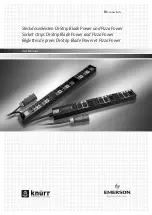
Page 15
DPBF1U & DPGF1U SERIES
OPERATING MANUAL
P O W E R I N G T E C H N O L O G Y
Document Number: DPBF-DPGF-MAN Rev. 5
dpbf_dpgf-man-Rev5-0719.indd
The Form C relay contact output connections are made to the spring clamp terminal blocks.
See Section 9.5. The chassis ground connection is made to the no. 8-32 stud. See Section
9.6. This safety ground connection should be made before operating the panel.
11.3
Checking Connections.
Carefully check the polarity of input connections to the distribution
panel and output connections to the load before operating the panel. Reverse connections
will not harm the distribution panel as reverese polarity protection is incorporated. However
it may cause serious harm to the load. Check to make sure that the chassis safety ground
connection is made. Make sure that all connections are clean and secure to minimize contact
resistance.
11.4
Rear Safety Cover.
Once all of the above have been completed, fit the clear plastic safety
cover to the back of the unit using the supplied mounting studs and screws. Instruction for
fitting the mounting studs the panel are included in the accessory kit.
12.0 SETUP AND TESTING
12.1
It is not necessary to have the distribution panel mounted in a rack for initial testing. This
can be done on a bench. It is also not necessary to have loads connected to the panel for
this testing.
12.2
With the input power source off, connect the input wires to the A side of the distribution
panel. Connect ground to the chassis ground terminal. Insert all fuses into fuse holders or
set all circuit breakers to on.
12.3
Turn on the input power source. The A side LED should be green. If it is red, one of the
fuses is blown or a circuit breaker is tripped. If the LED is off, there is no input power to
the unit. Check the output voltage at each set of output terminals with a digital voltmeter.
12.4
With the A side LED green, use an ohmmeter to check the Form C relay contact outputs.
On the upper row of the wire-wrap terminals (side A) measure the resistance between pins 1
and 2 and between pins 4 and 5. Both should read “short”. Measure the resistance between
pins 2 and 3 and between pins 5 and 6. Both should read “open”.
12.5
On the A side insert a blown fuse into fuse no. 1 position or trip circuit breaker no. 1. The
A side LED should turn red. On the upper row (side A) of wire wrap terminals, measure
the resistance between pins 1 and 2 and between pins 4 and 5. Both should read “open”.
Measure the resistance between pins 2 and 3 and between pins 5 and 6. Both should read
“short”. Replace the blown fuse with a good one or reset the circuit breaker.
12.6
On the A side check each succeeding fuse by replacing it with a blown fuse, or breaker by
tripping it, and verify that the LED turns red. It is not necessary to recheck the Form C
relay contacts.
































